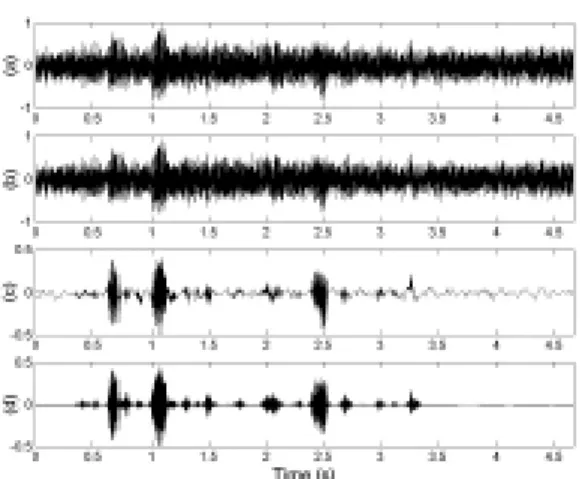Wavelet noise reduction : application to speech enhancement
Texte intégral
(2) Fig. 1. Speech enhancement results: a) noisy speech recorded in a aircraft plane, b) enhancement using WT with an universal threshold, c) enhancement using WT with level-dependent threshold, and d) enhancement using WPT with level-dependent threshold.. Fig. 2. Speech enhancement results: a) clean signal, b) noisy version (SNR=0dB), c) enhancement using WPT with level-dependent threshold, d) enhancement using WPT with level-dependent and timeadapted threshold.. 4. Proposed approach. References. The wavelet thresholding technique is a simple method to remove noise from corrupted signal. As pointed out previously, it was not successfully applied in speech enhancement. These difficulties are simultaneously associated to the speech signal complexity and to the nature of the noise. To improve the wavelet thresholding enhancement, we then propose: • The use of the WPT instead of the WT, • To extend the concept of the level-dependent threshold (Equation4) to the WPT, • The use of time-adapted threshold based on the speech waveform energy.. [1]. 5. Results The proposed approach is tested using speech sound corrupted by white noise and speech recorded in real environments (in a sawmill, in a car, and aircraft cockpit). The speech signal of Fig. 1-a is corrupted by a narrow-band noise. The standard threshold (the same value for all scales) of the WT (Fig. 1-b) is inefficient to remove noise (the same result is obtained by the standard threshold of the WPT). However, the filtered results using the level-dependent thresholding of the WPT are better when obtained by using the WT (respectively represented on Fig. 1-d and 1-c). The time-adapting effect is carried out using speech from the TIMIT database (Fig. 2-a) that is corrupted by white noise (Fig. 2-b). It can be seen that the enhanced speech using the time-adapted threshold becomes very close to the original clean speech (Fig. 2-d).. [2]. [3] [4] [5] [6] [7] [8] [9] [10] [11] [12] [13]. 5. Conclusion The proposed method constitutes a successful application of the wavelet thresholding for speech enhancement. The leveldependent threshold using WPT permits to remove various environmental noises (narrow or large frequency-band). Whereas, the time-adapting of the threshold avoids the speech degradation quality during the thresholding process.. [14]. [15]. S. Mallat and W.L. Hwang: Singularity Detection and Processing with Wavelets, IEEE Trans Inform Theory, 38 617643, 1992. D.L. Donoho. Nonlinear wavelet methods for recovering signals, images, and densities from indirect and noisy data. Proceedings of Synposia in Applied Mathematics, 47 :173–205, 1993. Y. Xu, J.B. Weaver, D.M Healy, and J. Lu. Wavelet transform domain filters: A spatially selective noise filtration technique. IEEE Trans. Image Processing, 3(6) :747–758, Nov. 1994. Q. Pan, L. Zhang, G. Dai, and H. Zhang, Two denoising methods by wavelet transform, IEEE Trans. Signal Processing, vol. 47, no. 12, pp. 3401–3406, December 1999. D.L. Donoho and I.M. Johnstone. Ideal spatial adaptation by wavelet shrinkage. Biometrika, 81(3) :425–455, 1994. D.L. Donoho. De-noising by soft-thresholding. IEEE Trans. Inform. Theory, 41(3) :613–627, May 1995. I.M. Johnstone and B.W. Silverman. Wavelet threshold estimators for data with correlated noise. J. Roy. Statist. Soc. B, 59 :319–351, 1997. D.L. Donoho and I.M. Johnstone. Adapting to unknow smoothness via wavelet shrinkage. J. Amer. Stat. Assoc., 1200–1224, 1995. X.P. Zhang and M.T. Desai. Adaptative denoising based on SURE risk. IEEE Signal Processing Letters, 5(10) :265–267, October 1998. B. Vidakovic and C.B. Lozoya. On time-dependant wavelet denoising. IEEE Trans. Signal Processing, 46(9) :2549–2554, September 1998. J.W. Seok and K.S. Bae. Speech enhancement with reduction of noise components in the wavelet domain. In ICASSP 1997, pages 1223–1326, Munich, Germany, April 1997. D. Mahmoudi. A microphone array for speech enhancement using multiresolution wavelet transform. In Proc. Of Eurospeech’97, pages 339–342, Rhodes, Greece, Sept. 1997. D. Mahmoudi and A. Drygajlo. Combined wiener and coherence filtering in wavelet domain for microphone array speech enhancement. In ICASSP98, pages 385 –388, 1998. T. Gulzow, A. Engelsberg, and U. Heute. Comparison of a discrete wavelet transformation and nonuniform polyphase filterbank applied to spectral-subtraction speech enhancement. Signal Processing, 64 :5–19, 1998. J. Sika and V. Davidek. Multi-channel noise reduction using wavelet filter bank. In EuroSpeech’97, pages 2591-2594, Rhodes, Greece, Sept. 1997..
(3)
Figure

Documents relatifs
Un des avantages de travailler avec l’espace des disparite´s re´side dans la sim- plicite´ a` expliciter le lien entre la projection gauche et droite d’un point contenu dans un
Whether or not ASD-relevant behavioral phe- notypes are present in an animal model of epilepsy, it is imperative that the criteria established for the endophenotypes of the
Ceci est indispensable pour pouvoir déplacer le sujet et son support, le maintenir dans le champ du viseur, et en même temps corriger la mise au point (en employant
The best recognition performance is obtained with the combination of the speech enhancement method of the two-stage, mel- warped, Wiener filter noise reduction
The same models as in the simulated data application (see Section 3.1.2) are compared in this real data application, excluding RF which cannot be used in the real data case.. Also,
e) Nous ncus intéressons surtout à l'effet que produit la construction de cette usine dans le pa2rs producteur de gaz, aussi nous ne détaillerons pas les investissements faits
Florian Metze, John Mcdonough, Hagen Soltau, Alex Waibel, Alon Lavie, Susanne Burger, Chad Langley, Lori Levin, Tanja Schultz, Fabio Pianesi, et al.. To cite
The simulated events were then passed through the same event reconstruction algorithms used for the data, including corrections for known differences between data and simulation in